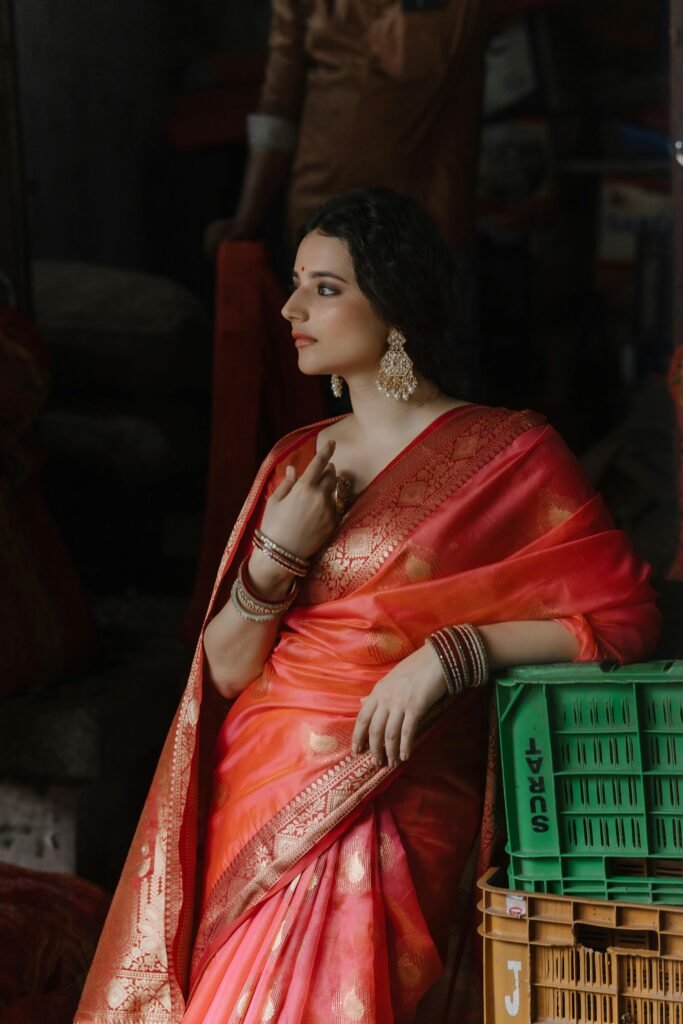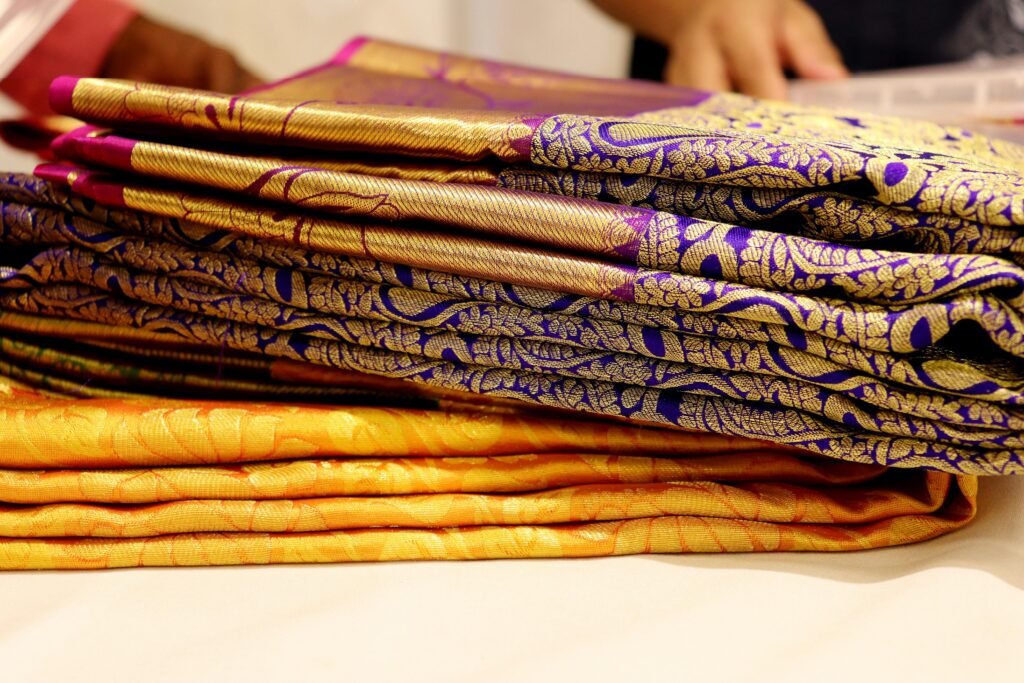Introduction: Why Banarasi Silk Sarees Are Every Woman’s Dream
Imagine draping a saree so exquisite that it feels like liquid gold against your skin—a masterpiece woven with centuries of heritage, love, and craftsmanship. That’s the magic of a Banarasi silk saree.

Originating from the holy city of Varanasi (Banaras), these sarees are not just clothing; they are heirlooms, passed down through generations, carrying stories of royal patronage, Mughal artistry, and timeless beauty.
Whether you’re a bride looking for the perfect wedding ensemble, a fashion lover seeking luxury, or someone who appreciates handcrafted art, a Banarasi silk saree is a must-have.
In this ultimate guide, we’ll uncover:
✅ The fascinating history of Banarasi sarees (Did you know Mughal queens adored them?)
✅ Different types (Which one suits your style—Katan, Organza, or Georgette?)
✅ The mind-blowing weaving process (It takes weeks to make just one saree!)
✅ Why they’re so expensive (Hint: It’s not just the gold zari!)
✅ How to spot a fake vs. real Banarasi saree (Don’t get scammed!)
✅ Modern styling hacks (Make your Banarasi saree look chic, not outdated!)
✅ FAQs (Your burning questions, answered!)
Ready to fall in love with Banarasi silk? Let’s begin!
1. The Royal Legacy: How Banarasi Sarees Became a Symbol of Luxury
A Gift from the Mughals
Banarasi silk sarees trace their roots back to the 14th century, when Mughal emperors brought Persian motifs and intricate weaving techniques to India. The royal courts of Varanasi became the epicenter of this luxurious craft, creating sarees fit for queens.
Did You Know?
- A single saree can take 15 days to 6 months to weave, depending on the complexity.
- Authentic Banarasi sarees have a GI tag (Geographical Indication), meaning only sarees made in Varanasi can carry this prestigious name.
- Bollywood’s favorite! Deepika Padukone, Aishwarya Rai, and Rekha have all dazzled in Banarasi silk.
2. Types of Banarasi Silk Sarees: Which One is Your Soulmate?
Not all Banarasi sarees are the same! Here’s a breakdown of the most popular types:
✨ Pure Katan Silk – The Queen of Banarasi Sarees
- What makes it special? 100% pure silk with heavy zari work.
- Best for: Bridal wear, grand weddings.
- Feels like: Wearing royalty!
✨ Organza (Kora) Silk – Ethereal & Lightweight
- What makes it special? Sheer, delicate, and embellished with zari.
- Best for: Engagement functions, receptions.
- Feels like: A dreamy fairy-tale look!
✨ Shattir Silk – The Comfortable Elegance
- What makes it special? Silk + cotton blend, lighter than Katan.
- Best for: Festive occasions, summer weddings.
- Feels like: Luxury without the weight!
✨ Georgette & Chiffon Banarasi – The Modern Twist
- What makes it special? Easier to drape, softer feel.
- Best for: Cocktail parties, stylish brunches.
- Feels like: Traditional charm with contemporary ease!
Pro Tip: If you’re a bride, go for Pure Katan. If you want something lightweight yet glamorous, Organza or Georgette is perfect!
3. The Secret Behind the Magic: How Banarasi Sarees Are Made
Step 1: Silk Thread Preparation
- Pure silk threads are dyed in vibrant colors.
Step 2: Handloom Weaving (The Real Artistry!)
- Skilled weavers work for weeks to months on a single saree.
- Real zari (gold/silver thread) is used for motifs like florals, peacocks, and Mughal-inspired designs.
Step 3: Embellishments & Finishing
- Additional embroidery, stones, or sequins may be added.
Fun Fact: Some weavers still use ancient wooden handlooms passed down through generations!
4. Why Are Banarasi Silk Sarees So Expensive?
Here’s the truth:
✔ Pure silk & real zari = High material cost.
✔ Handwoven, not machine-made = Labor-intensive.
✔ Takes weeks to complete = Time equals money.
✔ GI-tagged authenticity = No cheap duplicates.
But here’s the good news: A Banarasi saree is an investment—it never goes out of style and can last decades!
5. Fake vs. Real Banarasi Silk: How to Spot the Difference
🚩 Fake Alert Signs:
- Too cheap (under ₹5,000)? Probably synthetic.
- Shiny plastic-like zari? Not real gold/silver.
- Machine-made uniformity? Handloom has slight imperfections.
✅ Real Banarasi Silk Signs:
- Soft, slightly textured feel.
- Intricate handwoven designs.
- GI tag or seller authenticity proof.
Pro Tip: Buy from reputed stores or government-certified weavers to avoid fakes.
6. How to Style a Banarasi Saree Like a Fashion Pro
Gone are the days of boring drapes! Try these modern twists:
🔥 Contemporary Blouse:
- Try a crop top, deep back blouse, or cape-style drape.
🔥 Minimalist Jewelry:
- Let the saree shine—pair with dainty gold or polki jewelry.
🔥 Fusion Look:
- Wear it with a sleek belt or tuck the pallu like a gown.
🔥 Day-to-Night Hack:
- Day: Pair with a simple cotton blouse.
- Night: Add heavy jewelry and a bold lip!
FAQs: Your Banarasi Silk Questions Answered!
Q1: How much does a genuine Banarasi silk saree cost?
A: Prices start at ₹10,000 and can go up to ₹2 lakh+ for heavily embellished bridal pieces.
Q2: Can Banarasi silk sarees be worn in summer?
A: Yes! Opt for Shattir silk or lightweight Georgette versions.
Q3: How do I maintain a Banarasi saree?
A:
✔ Dry clean only.
✔ Store in muslin cloth to avoid moisture.
✔ No direct sunlight to prevent fading.
Q4: Are Banarasi sarees only for weddings?
A: Not at all! Modern designs work for festivals, parties, and even office wear (if styled subtly).
Q5: Where can I buy authentic Banarasi sarees?
A:
✔ Varanasi’s local markets (e.g., Vishwanath Lane, Lahurabir).
✔ Reputed online stores (e.g., Jaypore, Sundari Silks).
✔ Government emporiums (for certified weavers).
Final Thoughts: Why Every Woman Needs a Banarasi Silk Saree
A Banarasi silk saree is more than fabric—it’s art, heritage, and emotion woven together. Whether you’re a bride, a fashionista, or someone who values craftsmanship, owning one is like owning a piece of history.
So, the next time you drape a Banarasi saree, remember—you’re not just wearing a saree, you’re carrying forward 500 years of legacy.
Now, tell us—which Banarasi saree stole your heart? 💖 Share in the comments!

